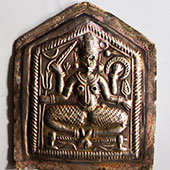The making of Taak is considered as pure and divine as its functionality. The basic materials like silver and copper sheets are sourced from Mumbai. The making starts with cutting the silver and copper sheets according to the required measurements. The impression of desired deity is created with the help of a predesigned die by placing a piece of silver sheet on it and frequent and continues beating. While doing the beating process a small piece of tin is kept on the silver sheet and then it is hammered for achieving more defined embossed impression. Once the desired impression is obtained the embossed silver sheet is removed carefully from the die (engraved mold). Later on the sides are trimmed off to get desired shape.
Once the silver embossed image is ready it is taken for filling and framing. The purpose of filling process is to prevent the embossed image from getting dents and give tenacity as well as longevity. The filling process is done by heating copper plate and arranges lac on the copper plate in a square format. Once the lac is fired well into a particular consistency it is spread evenly with the help of metal rod. Then the embossed silver image is placed right in the center and firmly pressed, it helps the excess lac to come out. The excess amounts of lac are removed. Afterwards the whole composition is removed from the fire and set aside for cooling down. Once the composition is cooled the edged of the copper sheets are trimmed off into the similar shape of silver embossed sheet. After wards the edges are folded twice and overlapped on to the embossed silver image. After overlapping is done the edges are hammered carefully to provide grip. Once the copper overlapping is done the Taak is ready.























































